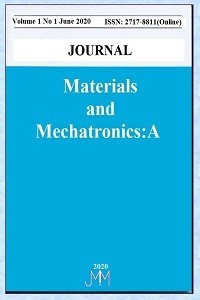Pomza Taşının Otomotiv Sürtünme Malzemesi Olarak Kullanımının Araştırılması
Fren balatası, Sürtünme katsayısı, Pomza taşı, Triboloji, Aşınma
Investigation of the Use of Pumice Stone as Automotive Friction Material
Brake pad, Friction coefficient, Pumice stone, Tribology, Wear,
___
- Ademoh N. A., Olabisi A. I., Development and evaluation of maize husks (asbestos-free) based brake pad, Industrial Engineering Letters 5, 2, 2015.
- Ahlawat V., Anuradha P., Kajal S., Preference selection of brake friction composite using entropy-VIKOR technique, In Materials Today: Proceedings 46, 9573–9579, 2019.
- Akagündüz E., Topuz A., Güneş M., 2014, Effects of fly ash additive on the properties of railway composite disc brake linings, journal of engineering and natural sciences, Sigma, 32, 322–333.
- Akıncıoğlu G., Ticari araç balatalarına ceviz ve fındık kabuğu tozu katkılarının aşınma ve sürtünme davranışına etkisinin incelenmesi, Düzce Üniversitesi Fen Bilimleri Enstitüsü, Doktora Tezi (Basılmış), 2018.
- Akıncıoğlu G., Uygur İ., Akıncıoğlu S., Öktem H., Friction-wear performance in environmentally friendly brake composites: a comparison of two different test methods, Polymer Composites 42, 4461–4477, 2021.
- Anderson A. E., Friction and wear of automotive brakes, USA, Friction, lubrication and wear technology, ASM Handbook, 1992.
- Anonim 2015. https://ahika.gov.tr/assets/ilgilidosyalar/Pomza-Arastirma-ve-Uygulama-Merkezi-Fizibilite-Raporu.pdf / (Erişim Tarihi: 24.12.2022).
- Anonim 2022. https://www.mta.gov.tr/v3.0/bilgi-merkezi/pomza / (Erişim Tarihi: 03.11.2022).
- Aras S., Organik malzeme esaslı hibrit sürtünme kompozitlerinin balata üretiminde kullanılabilirliğinin incelenmesi, Selçuk Üniversitesi Fen Bilimleri Enstitüsü, Doktora Tezi (Basılmış), 2019.
- Binda F. F., Oliveira V. D. A., Fortulan C. A., Palhares L. B., Santos C. G., Friction elements based on phenolic resin and slate powder, Journal of Materials Research and Technology 9 (3), 3378–3383, 2020.
- Che Q., Li H., Zhang L., Zhao F., Li G., Guo Y., Zhang, J., Role of carbon nanotubes on growth of a nanostructured double-deck tribofilm yielding excellent self-lubrication performance, Carbon, 161, 445–455, 2020.
- Jeganmohan S., Sugözü B., Usage of powder pinus brutia cone and colemanite combination in brake friction composites as friction modifier, In Materials Today: Proceedings 27, 2072–2075, 2019.
- Kchaou M., Kuş R., Singaravelu D.L., Design, characterization, and performance analysis of Miscanthus fiber reinforced composite for brake application, Journal of Enggineerin Research 9 (3), 222–234, 2021.
- Maleque M., Atiqah, A., Talib R., Zahurin H., New natural fibre reinforced aluminium composite for automotive brake pad, International Journal of Mechanical and Materials Engineering 7, 166–170, 2012.
- MAPEG, 2022. https://www.mapeg.gov.tr/Custom/Madenistatistik / (Erişim Tarihi: 21.12.2022).
- Persson B. N. J., Theory of friction- the role of elasticity in boundary lubrication, Physical Review B 50 (7), 4771–4786, 1994.
- Pujari S., Srikiran S., Experimental investigations on wear properties of palm kernel reinforced composites for brake pad applications, Defence Technology 15 (3), 295–299, 2019.
- Singh T., Pruncu C. I., Gangil B., Singh V., Fekete G., Comparative performance assessment of pineapple and kevlar fibers based friction composites, Journal of Materials Research and Technology 9 (2), 1491–1499, 2020.
- Stachowiak G. W., Batchelor A. W., Engineering Tribology, Butterworth-Heinemann, 883s, USA, 2014.
- Stadler Z., Krnel K., Kosmac T., Friction behavior of sintered metallic brake pads on a C/C-SiC composite brake disc, Journal of the European Ceramic Society 27, 1411–1417, 2007.
- Sugözü B., Nano silika, nano alümina ve nano zirkon aşındırıcı parçacık katkısının fren balata özelliklerine etkisi, Selçuk Üniversitesi Fen Bilimleri Enstitüsü, Doktora Tezi (Basılmış), 2016.
- Sugözü B., Sugözü İ., Investigation of the use of a new binder material in automotive brake pad, International Journal of Automotive Science and Technology 4(4), 258–263, 2020.
- Tabor D., Friction as a dissipated process, friction of organic polymers in fundamentals of friction, Macroscopic and Microscopik Processes 3, 220, 1996.
- Timur M., Kılıç H., Marble waste using produced of automotive brake pad of friction coefficient different pad brake pads with comprasion, Pamukkale University Journal of Engineering Sciences 19(1), 10–14, 2013.
- Toyota, 2022. https://blog.toyota.com.tr/fren-balatasi-nedir-ne-zaman-degistirilir/ (Erişim Tarihi: 28.12.2022).
- TS 555, Karayolu taşıtları–fren sistemleri-sürtünmeli frenler için balatalar, TSE, 2019.
- TÜİK, 2022. https://data.tuik.gov.tr/Bulten/Index?p=Motorlu-Kara-Tasitlari-Kasim-2022-45714/ (Erişim Tarihi: 22.12.2022).
- Yavuz H., Bayrakçeken H., Friction and wear characteristics of brake friction materials obtained from fiber and huntite blends, Industrial Lubrication and Tribology 74(7), 844–852, 2022.
- Yayın Aralığı: Yılda 2 Sayı
- Başlangıç: 2020
- Yayıncı: Yusuf KAYALI
Isıl İşlemin Bakır Kaplı Çelik Boruların Mekanik Özelliklerine Etkisinin Araştırılması
Ozan KOYUNCU, Burak ÇELİK, Yasin AKGÜL, Alper İNCESU
Mikro-Frezeleme Yöntemi ile İşlenen İnce Duvarlı Yapılarda Deformasyonun İncelenmesi
Ahmet HASÇELİK, Kubilay ASLANTAS
Osman Bahadır ÖZDEN, Barış GÖKÇE, Abdullah ERDEMİR
Sonlu Ufukta Genelleştirilmiş Kesinlik Eşdeğerlerinin Optimizasyonu
Pomza Taşının Otomotiv Sürtünme Malzemesi Olarak Kullanımının Araştırılması
Emin ÇENGELCİ, Hüseyin BAYRAKÇEKEN
Eş Merkezli İç İçe Borulu Isı Değiştiricisinde GO-Al2O3/Su Hibrit Nanoakışkanının Deneysel Analizi
